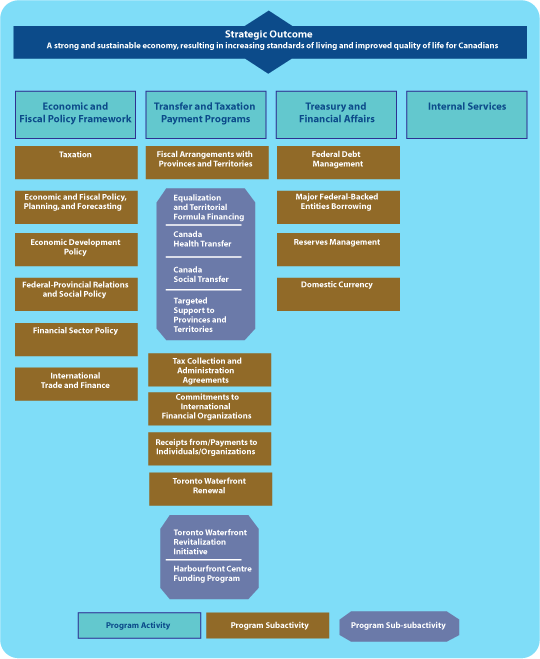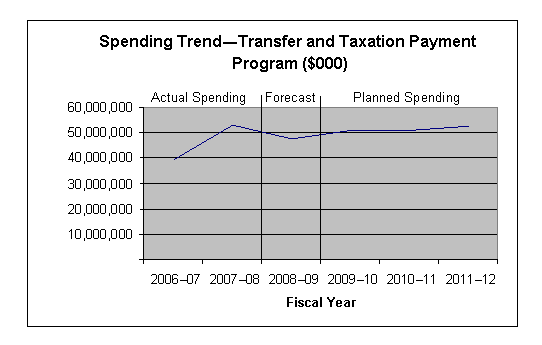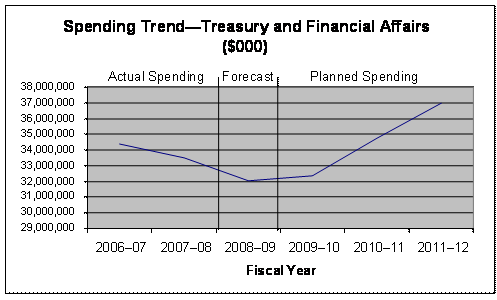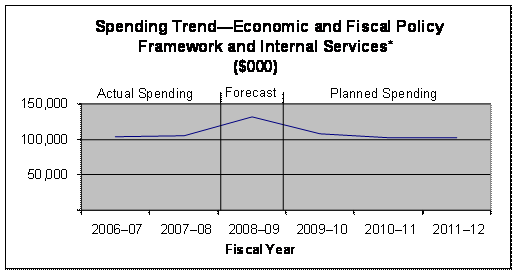Common menu bar links
Breadcrumb Trail
ARCHIVED - Department of Finance Canada
 This page has been archived.
This page has been archived.
Archived Content
Information identified as archived on the Web is for reference, research or recordkeeping purposes. It has not been altered or updated after the date of archiving. Web pages that are archived on the Web are not subject to the Government of Canada Web Standards. As per the Communications Policy of the Government of Canada, you can request alternate formats on the "Contact Us" page.
 |
Minister's MessageSince last year's Report on Plans and Priorities (RPP) for the Department of Finance Canada was issued, the global economic and fiscal climate has changed dramatically. Canada is being buffeted by gales blowing in from around the world, including recession in the U.S., Japan, and many of the Euro-zone countries; ongoing financial market volatility; and sharp declines in commodity prices. This government has already made great progress in responding to the worsening global economic downturn. We have reduced debt, cut taxes, and made historic investments in infrastructure, science and technology, education, and training. |
Canada's Economic Action Plan: Budget 2009 further builds on our position of strength. It provides temporary and effective economic stimulus to help Canadian families and businesses deal with short-term challenges. Our investments will build Canada's long-term capacity so that when the global recession eases we will emerge even stronger.
Nevertheless, the year ahead will be a challenging one for the Department of Finance Canada and, indeed, the entire federal government. However, as this Report on Plans and Priorities demonstrates, we are focussing on measures that foster sound fiscal management and stimulate sustainable economic growth.
We are scrutinizing every dollar to ensure that investments by the federal government are affordable. Our spending decisions will recognize the need to invest in our country at a time when the economy needs a boost. And we will do so while avoiding the long-term, structural deficits Canadians have worked hard to eliminate and never want to see return.
We are rolling up our sleeves and taking all necessary steps to keep our economy strong through these tough times. I am confident that, guided by the initiatives highlighted in this Report on Plans and Priorities, we will overcome whatever hardships may lie ahead in the next year, and beyond.
Section I: Departmental Overview
The Department of Finance Canada, established in 1867, is one of the original departments of the Government of Canada. Originally, the Department's primary functions—conducted by a staff of only 28 officers, clerks, and messengers—were bookkeeping, administering the collecting and spending of public monies, and servicing the national debt.
Today, as we move towards the Department's and the country's 150th anniversary, the Department continues to play a vital role in helping the Government of Canada develop the social, tax, and economic policies that will support the standard of living and quality of life of Canadians, their families, and their communities in the years to come—and it does so as one of the government's smallest departments.
Raison d'être
The Department is committed to making a difference for Canadians by helping the Government of Canada develop and implement strong and sustainable economic, fiscal, tax, social, security, international, and financial-sector policies and programs. It plays an important role in ensuring that government spending is focussed on results and delivers value for taxpayer dollars. The Department interacts extensively with other federal departments and agencies and plays a pivotal role in the analysis and design of public policy across a wide range of issues affecting Canadians.
Responsibilities
The Department of Finance Canada's responsibilities include the following:
- preparing the federal budget;
- developing tax and tariff policy and legislation;
- managing federal borrowing on financial markets;
- administering major transfers of federal funds to the provinces and territories;
- developing regulatory policy for the country's financial sector; and
- representing Canada within international financial institutions and groups.
The Department also plays an important role as a central agency working with other departments to ensure that the government's agenda is carried out and that ministers are supported with first-rate analysis and advice.
Strategic Outcome and Program Activity Architecture (PAA)
The Department of Finance Canada provides effective economic leadership with a clear focus on one strategic outcome.

Operating environment and risk analysis
In late 2008, the global economic outlook deteriorated markedly. This was particularly evident in the U.S. and other advanced economies but is also increasingly apparent in emerging market economies. There is now a broad consensus that the Canadian economy entered a recession in the fourth quarter of 2008.
Over the coming years, the state of the economy will remain a major issue given the current worldwide economic slowdown and financial markets turmoil. The global financial crisis and the further weakening of the U.S. economy will inevitably continue to affect the Canadian economy.
Overall, however, the domestic economic situation remains better than in most other major industrialized countries, in particular the U.S. Canada's banks and other financial institutions are sound and well capitalized. The financial position of Canadian households and businesses remains solid, and Canada has maintained the strongest fiscal performance of all G7 countries.
The main risk to the global economy is that financial market dislocations could be more prolonged than currently expected, resulting in a longer period of high business and consumer borrowing costs and reduced credit availability. Should this transpire, global consumer spending and business investment would be weaker than currently forecast.
For Canada, the risk is compounded by the risk stemming from low and volatile commodity prices. As a result, there is considerable uncertainty about how commodity prices will affect nominal income growth in Canada.
An aging population, the volatility of both resource prices and the value of the Canadian dollar, and the increasingly uncertain economic outlook will, combined, put added pressure on government programs and services. These will require careful management and greater scrutiny in order to ensure that they remain accessible, sustainable, and effective for Canadians.
Operational priorities
The current global economic situation emphasizes the importance of bolstering Canada's solid economic fundamentals. To this end, the Department of Finance Canada will focus on four key ongoing operational priorities for 2009–10.
Sound fiscal management
Over the planning period, the Department of Finance Canada will continue to play a major role in ensuring that the government continues to manage spending responsibly, maximizes the benefits of government assets to Canadians, and that measures are taken to ensure the effectiveness and to reduce the cost of government operations.
The Department will also work to protect Canada's macroeconomic framework and ensure the sustainability of Canada's social safety net. Maintaining a sound fiscal framework, including a competitive, efficient, and fair tax system, is critical in uncertain economic times.
Finally, the Department will continue to manage Government of Canada funds in accordance with the guiding principles of transparency, regularity, liquidity, and prudence. Sound management of public finances provides significant benefits to Canadians and businesses in Canada. It gives the government the strength to withstand fiscal and economic challenges and ensures that the costs of investments and services are not passed on to future generations.
Sustainable economic growth
The Department promotes sustainable economic growth by developing and implementing policies and programs that provide appropriate support for the drivers of productivity growth: business investment, public infrastructure, human capital, innovation, and financial market governance.
As the government's source of analysis and advice on economic and fiscal matters, the Department will continue to help ensure that policies and programs create the conditions necessary for sustainable long-term economic growth and help the country emerge from the global economic downturn.
Sound social policy framework
The government supports social programs delivered by provinces and territories—including social assistance, social services, post-secondary education, and programs for children—by means of transfers to provincial and territorial governments.
Through its analysis and advice, the Department contributes to the government's efforts to meet its objectives for the quality of Canada's communities, health care, education, and social safety net programs and to ensure equality of opportunity for all citizens.
The Department also designs and administers transfers to provinces and territories and undertakes regular reviews and consultations with them, as well as with interested stakeholders, academics, and other experts.
Effective international influence
The Department is working with other G20 countries to address the causes of the current international financial crisis, determine actions to stabilize financial markets and growth, and reform the global financial system to prevent a similar crisis from occurring again.
The Department will also continue to advance Canada's leadership in a wide range of international financial institutions and economic organizations in order to strengthen global growth and stability, promote Canada's trade and investment interests, help foster development aimed at reducing global poverty, endorse policies and programs that support maintaining secure and open borders, and further international standards to prevent abuses to the international financial system, including anti-terrorist financing.
Finally, the Department will assist the government in creating economic conditions that encourage Canadian firms to invest, flourish, and take advantage of trade and foreign investment.
| More information about the Department of Finance Canada's priorities can be found in Canada's Economic Action Plan: Budget 2009. |
Planning summary1
| 2009–10 | 2010–11 | 2011–12 |
|---|---|---|
| 83,240,888.92 | 85,592,129.3 | 89,757,232.9 |
| 2009–10 | 2010–11 | 2011–12 |
|---|---|---|
| 765 | 765 | 765 |
| Performance Indicators3 | Targets |
|---|---|
| Canada's medium-term fiscal framework |
|
|
Competitiveness, efficiency, and fairness of Canada's tax system |
|
|
Soundness, efficiency, and competitiveness of Canada's financial sector |
|
| Program Activity | Forecast Spending 2008–09 |
Planned Spending | Alignment to Government of Canada Outcomes | ||
|---|---|---|---|---|---|
| 2009–10 | 2010–11 | 2011–12 | |||
|
PA 1: Economic and Fiscal Policy Framework |
131,935.2 | 65,049.3 | 59,614.8 | 59,453.8 |
|
|
PA 2: Transfer and Taxation Payment Programs |
47,865,330.9 | 50,743,524.6 | 50,716,302.2 | 52,657,672.9 |
|
|
PA 3: Treasury and Financial Affairs |
32,027,701.2 | 32,389,701.2 | 34,773,701.2 | 36,997,701.2 |
|
|
PA 4: Internal Services |
— | 42,613.8 | 42,511.0 | 42,405.0 |
|
| Total Planned Spending | 83,240,888.9 | 85,592,129.3 | 89,757,232.9 | ||
Expenditure profile
For the 2009–10 fiscal year, the Department of Finance Canada plans to spend $83.2 billion to meet the expected results of its program activities and contribute to its strategic outcome. The figures below illustrate the Department's spending trend by program activity from 2006–07 to 2011–12.

The increase in actual spending for Transfer and Taxation Payment Programs from 2006–07 to 2007–08 is mainly due to increases of $3.8 billion in transfer payments (Fiscal Equalization, Canada Social Transfer, and Canada Health Transfer), $4.6 billion in one-time statutory payments, and $4.8 billion in loans to Crown corporations.
The increase in forecast and planned spending is due to increased transfer payments for Fiscal Equalization, Canada Social Transfer, and Canada Health Transfer.

Treasury and Financial Affairs includes domestic coinage and interests and other costs related to the public debt. The variation in actual spending from 2006–07 to 2007–08 is mostly due to lower interest rates and reductions in market debt. The forecast and planned spending vary depending on the forecast interest rates.

* Starting in 2009–10, the spending for Internal Services is being presented separately in the various tables of the RPP, but it is combined with the Economic and Fiscal Policy Framework program activity in this graph in order to show comparable data.
Spending for the Economic and Fiscal Policy Framework and Internal Services program activities mainly includes operating expenditures and the employee benefits plan. The increase in forecast spending in 2008–09 is mainly due to time-limited funding for two new panels and an advertising campaign, partially offset by a reduction for the strategic review allocation. Planned spending for 2009–10 includes $5 million in time-limited funding for an advertising campaign.
| Vote # or Statutory Item (S) | Truncated Vote or Statutory Wording | 2009-10 Main Estimates |
2008–09 Main Estimates |
|---|---|---|---|
| 1 | Operating expenditures1 | 93,603 | 89,793 |
| 5 | Grants and contributions2 | 331,886 | 374,800 |
| (S) | Minister of Finance—salary and motor car allowance | 78 | 76 |
| (S) | Territorial Financing (Part I.1—Federal-Provincial Fiscal Arrangements Act)3 | 2,497,926 | 2,312,939 |
| (S) | Payments to International Development Association4 | 384,280 | 318,280 |
| (S) | Contributions to employee benefits plan5 | 11,549 | 11,910 |
| (S) | Purchase of domestic coinage6 | 150,000 | 147,000 |
| (S) | Interest and other costs7 | 31,868,000 | 33,683,000 |
| (S) | Statutory subsidies (Constitution Acts, 1867–1982, and other statutory authorities) | 32,000 | 32,000 |
| (S) | Fiscal Equalization (Part I—Federal-Provincial Fiscal Arrangements Act)8 | 16,086,136 | 13,619,924 |
| (S) | Canada Health Transfer (Part V.1—Federal-Provincial Fiscal Arrangements Act)9 | 23,987,062 | 22,629,304 |
| (S) | Canada Social Transfer (Part V.1—Federal-Provincial Fiscal Arrangements Act)10 | 10,860,781 | 10,557,729 |
| (S) | Wait Times Reduction Transfer (Part V.1—Federal-Provincial Fiscal Arrangements Act)11 | 250,000 | 0 |
| (S) | Youth Allowances Recovery (Federal-Provincial Fiscal Revision Act, 1964)12 | (688,935) | (717,374) |
| (S) | Alternative Payments for Standing Programs (Part VI—Federal-Provincial Fiscal Arrangements Act)13 | (3,124,006) | (3,256,839) |
| (S) | Incentive for provinces to eliminate taxes on capital (Budget Implementation Act, 2007)14 | 123,000 | 0 |
| — | Items not required Payment to Ontario (Budget Implementation Act, 2007)15 |
0 | 150,000 |
| Total budgetary | 82,863,360 | 79,952,542 | |
| L10 | In accordance with the Bretton Woods and Related Agreements Act, the issuance and payment of non–interest bearing, non-negotiable demand notes in an amount not to exceed $384,280,000 to the International Development Association | 0 | 0 |
| (S) | Payments and encashment of notes issued to the European Bank for Reconstruction and Development—Capital subscriptions16 | 1,749 | 3,075 |
| Total non-budgetary | 1,749 | 3,075 | |
| Total Department | 82,865,109 | 79,955,617 |
Notes:
1. The increase of $3.8 million or 4.2 per cent in operating expenditures is mainly due to increases for advertising campaigns, securities regulations, corporate services funding, and collective agreements and offset primarily by the strategic review reallocations, transfer of collective agreement provisions to the Treasury Board of Canada Secretariat, and cost-efficiency savings. The transfer of the Toronto Waterfront Revitalization Initiative (TWRI) and Harbourfront Centre from Environment Canada also contributed to the increase in the operating budget.
2. The decrease of $42.9 million or 11.5 per cent in grants and contributions is mainly due to reprofiled amounts from 2007–08 to 2008–09 of certain grants, updated estimates of debt relief in 2009–10, and completion of contribution payments in 2008–09. The decrease is partly offset by new contributions related to the TWRI.
3. The increase of $185 million in transfer payments for Territorial Formula Financing (TFF) is a result of the new formula for TFF that was announced in Budget 2007.
4. The increase of $66 million reflects the required amounts for the first note encashment of International Development Association (IDA) agreement No. 15. This note will be issued in January 2009 (fiscal year 2008–09) and encashed in 2009–10.
5. The decrease in contributions to the employee benefits plan reflects changes in salary costs included in operating expenditures.
6. The increase of $3 million or 2.04 per cent reflects the increased funding required to cover the cost of producing and distributing the domestic coinage to meet the needs of the economy.
7. Forecast public debt charges have decreased due mainly to a downward revision of the expected average interest rate on the stock of interest-bearing debt.
8. The increase of $2.466 billion or 18.11 per cent in transfer payments for Equalization is a result of the new formula for Equalization that was announced in Budget 2007. In November 2008, the Minister of Finance established a sustainable growth path for the Equalization program and announced an Equalization level for 2009–10 of $14.185 billion. The legislation was not introduced before prorogation and will be tabled after Parliament resumes. Consequently, the figure in the Main Estimates, $16.1 billion, is based on the formula that is currently legislated.
9. The increase of $1.358 billion reflects the 6-per-cent increase in funding commitments in the September 2004 10-Year Plan to Strengthen Health Care.
10. The increase of $303.1 million or 2.9 per cent represents the legislated amount for the Canada Social Transfer following new commitments set out in Budget 2007.
11. Budget 2005 committed to a transfer of $5.5 billion for wait times reduction. Of this $5.5 billion, $4.25 billion was provided to provinces and territories by way of third-party trusts. The remaining $1.25 billion will be paid in bimonthly instalments totalling $250 million per year between 2009–10 and 2013–14.
12. The decreased recovery of $28.4 million is related to a decrease in the estimated value of personal income tax points.
13. The decreased recovery of $132.8 million is attributable to a decrease in the value of personal income tax points.
14. All estimated costs are based on provincial announcements of capital tax reductions to date.
15. The funding announced in Budget 2007 to assist the province of Ontario in the transition to a single corporate tax administration included two payments: one in 2007–08 and the other in 2008–09.
16. The decrease reflects the agreed schedule of Canada's payments and encashments for the European Bank for Reconstruction and Development's 1998 capital subscription increase and the effects of exchange rate changes.
